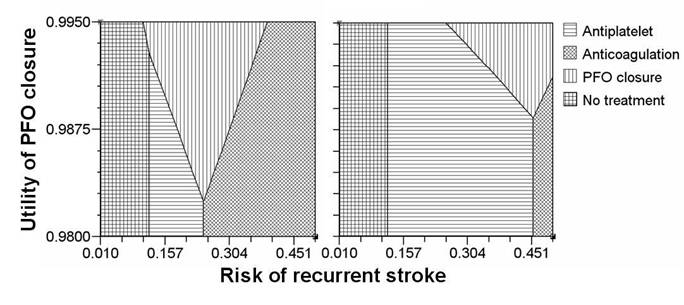| Meeting Brochure and registration form SMDM Homepage | |

|

|
|
||||
Purpose: We developed a decision analysis model in order to identify the preferred management for such an initial clinical scenario, among the following options: anticoagulation (AC), antiplatelet medication, percutaneous PFO closure or no treatment.
Methods: We systematically searched for the best evidence in the medical literature and built a decision tree (TreeAge). The main outcomes considered, within a one year time horizon, included recurrent stroke and complications of treatment options.
Results: We found no randomized trials relevant to our decision model. Optimal management choice was found most sensitive to risk of recurrent stroke, efficacy and utility of PFO closure, risk of ICH and death from AC, also confirmed by Monte-Carlo simulation. A preliminary multiple-way sensitivity analysis is shown below: on the left, for optimistic efficacies of PFO closure and AC; on the right, for lesser efficacies of these modalities.
Conclusions: Poor quality of evidence on efficacy of PFO closure and risk from AC prevents a confident approach in decision making for cryptogenic stroke in the scenario presented. Optimal decision is critically influenced by assumptions about embolic etiology, efficacy and safety of related treatments, risk of recurrence and personal utilities. The latter could potentially be affected by public expectations when a leading politician's health is at stake. 
See more of Poster Session II
See more of The 28th Annual Meeting of the Society for Medical Decision Making (October 15-18, 2006)